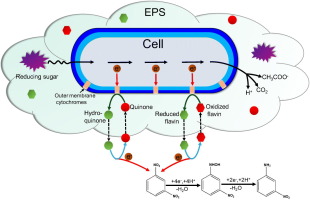当前位置:
X-MOL 学术
›
Sci. Total Environ.
›
论文详情
Our official English website, www.x-mol.net, welcomes your feedback! (Note: you will need to create a separate account there.)
Probing extracellular reduction mechanisms of Bacillus subtilis and Escherichia coli with nitroaromatic compounds.
Science of the Total Environment ( IF 9.8 ) Pub Date : 2020-03-28 , DOI: 10.1016/j.scitotenv.2020.138291 Xinwei Zhou 1 , Fuxing Kang 2 , Xiaolei Qu 1 , Heyun Fu 1 , Juan Liu 3 , Pedro J Alvarez 4 , Dongqiang Zhu 5
Science of the Total Environment ( IF 9.8 ) Pub Date : 2020-03-28 , DOI: 10.1016/j.scitotenv.2020.138291 Xinwei Zhou 1 , Fuxing Kang 2 , Xiaolei Qu 1 , Heyun Fu 1 , Juan Liu 3 , Pedro J Alvarez 4 , Dongqiang Zhu 5
Affiliation

|
Redox transformations of organic contaminants by bacterial extracellular polymeric substances (EPS) and the associated electron transfer mechanisms are rarely reported. Here we show that a nitroaromatic compound (1,3-dinitrobenzene) can be readily reduced to 3-hydroxylaminonitrobenzene and 3-nitroaniline in aqueous suspension of common bacteria (E. coli or B. subtilis) or in aqueous dissolved EPS extracted from the bacteria. The loss ratio of 1,3-dinitrobenzene by E. coli was unaffected after knocking out the nfsA gene encoding nitroreductase, but was suppressed by removing EPS attached to cells. In contrast, the loss ratio was enhanced by adding aqueous dissolved EPS to E. coli or B. subtilis suspension. The residual 1,3-dinitrobenzene and products formed after reduction were only presented outside the bacterial cells. Thus, bacterial reduction of 1,3-dinitrobenzene was mediated by nonenzymatic extracellular reduction. This was further corroborated by the observation that the stoichiometric demand of electrons in 1,3-dinitrobenzene reduction was nearly equal to the quantity of electrons donated by bacterial cells in the electrochemical cell experiment. Inhibition on the reduction of 1,3-dinitrobenzene by chemical probes combined with fluorescence detection demonstrated that reducing sugars in EPS might act as electron donors, while cytochromes and some low-molecular weight molecules (flavins and quinones) were involved as electron transfer mediators. Linear relationships were observed between the reduction kinetics and the one-electron reduction potentials for a series of substituted dinitrobenzenes in the presence of bacterial cells or dissolved EPS. Their close linear regression slope values suggest that the extracellular matrix and the exfoliated EPS utilized the same reducing agents (likely hydroquinones and reduced flavins) as terminal electron donors to reduce NACs. These results reveal a previously unrecognized mechanism for nonenzymatic extracellular reduction of NACs by common bacteria. CAPSULE: The extracellular matrix of E. coli or B. subtilis supplies both electron donors and electron transfer mediators to efficiently reduce nitroaromatic compounds.
中文翻译:

用硝基芳族化合物探索枯草芽孢杆菌和大肠杆菌的细胞外还原机制。
细菌胞外聚合物(EPS)和相关的电子转移机制的有机污染物的氧化还原转化很少报道。在这里,我们表明,在常见细菌(大肠杆菌或枯草芽孢杆菌)的水悬浮液中或从细菌提取的溶解的EPS水溶液中,硝基芳族化合物(1,3-二硝基苯)可以很容易地还原为3-羟基氨基硝基硝基苯和3-硝基苯胺。 。敲除编码硝基还原酶的nfsA基因后,大肠杆菌的1,3-二硝基苯的损失率不受影响,但是通过除去附着在细胞上的EPS而被抑制。相反,通过将溶解的EPS水溶液添加到大肠杆菌或枯草芽孢杆菌悬浮液中来增加损失率。还原后形成的残留1,3-二硝基苯和产物仅存在于细菌细胞外部。从而,1,3-二硝基苯的细菌还原是通过非酶促细胞外还原介导的。1,3-二硝基苯还原过程中电子的化学计量要求几乎等于在电化学电池实验中细菌细胞捐赠的电子数量,这进一步证实了这一点。化学探针结合荧光检测抑制1,3-二硝基苯还原表明EPS中的还原糖可能充当电子供体,而细胞色素和一些低分子量分子(黄素和醌)则作为电子传递介质。在细菌细胞或溶解的EPS存在下,一系列取代的二硝基苯的还原动力学与单电子还原电位之间存在线性关系。它们接近的线性回归斜率值表明,细胞外基质和脱落的EPS使用与末端电子供体相同的还原剂(可能是对苯二酚和还原的黄素)来还原NAC。这些结果揭示了以前未被认识到的常见细菌对NAC进行非酶促细胞外还原的机制。胶囊:大肠杆菌或枯草芽孢杆菌的细胞外基质既可提供电子供体,又可提供电子转移介体,以有效还原硝基芳香族化合物。
更新日期:2020-03-28
中文翻译:

用硝基芳族化合物探索枯草芽孢杆菌和大肠杆菌的细胞外还原机制。
细菌胞外聚合物(EPS)和相关的电子转移机制的有机污染物的氧化还原转化很少报道。在这里,我们表明,在常见细菌(大肠杆菌或枯草芽孢杆菌)的水悬浮液中或从细菌提取的溶解的EPS水溶液中,硝基芳族化合物(1,3-二硝基苯)可以很容易地还原为3-羟基氨基硝基硝基苯和3-硝基苯胺。 。敲除编码硝基还原酶的nfsA基因后,大肠杆菌的1,3-二硝基苯的损失率不受影响,但是通过除去附着在细胞上的EPS而被抑制。相反,通过将溶解的EPS水溶液添加到大肠杆菌或枯草芽孢杆菌悬浮液中来增加损失率。还原后形成的残留1,3-二硝基苯和产物仅存在于细菌细胞外部。从而,1,3-二硝基苯的细菌还原是通过非酶促细胞外还原介导的。1,3-二硝基苯还原过程中电子的化学计量要求几乎等于在电化学电池实验中细菌细胞捐赠的电子数量,这进一步证实了这一点。化学探针结合荧光检测抑制1,3-二硝基苯还原表明EPS中的还原糖可能充当电子供体,而细胞色素和一些低分子量分子(黄素和醌)则作为电子传递介质。在细菌细胞或溶解的EPS存在下,一系列取代的二硝基苯的还原动力学与单电子还原电位之间存在线性关系。它们接近的线性回归斜率值表明,细胞外基质和脱落的EPS使用与末端电子供体相同的还原剂(可能是对苯二酚和还原的黄素)来还原NAC。这些结果揭示了以前未被认识到的常见细菌对NAC进行非酶促细胞外还原的机制。胶囊:大肠杆菌或枯草芽孢杆菌的细胞外基质既可提供电子供体,又可提供电子转移介体,以有效还原硝基芳香族化合物。



























 京公网安备 11010802027423号
京公网安备 11010802027423号